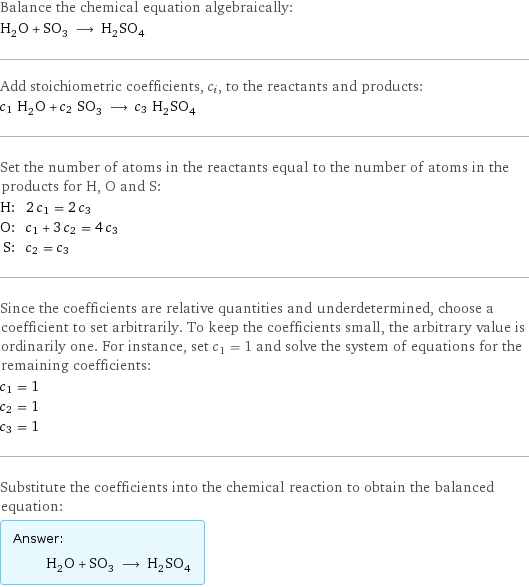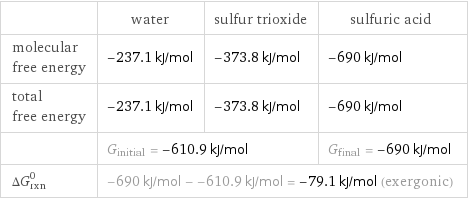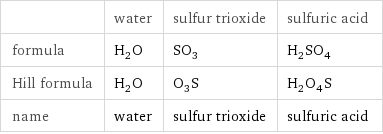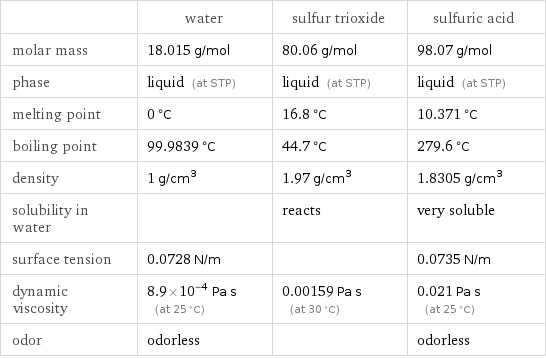Input interpretation

H_2O (water) + SO_3 (sulfur trioxide) ⟶ H_2SO_4 (sulfuric acid)
Balanced equation

Balance the chemical equation algebraically: H_2O + SO_3 ⟶ H_2SO_4 Add stoichiometric coefficients, c_i, to the reactants and products: c_1 H_2O + c_2 SO_3 ⟶ c_3 H_2SO_4 Set the number of atoms in the reactants equal to the number of atoms in the products for H, O and S: H: | 2 c_1 = 2 c_3 O: | c_1 + 3 c_2 = 4 c_3 S: | c_2 = c_3 Since the coefficients are relative quantities and underdetermined, choose a coefficient to set arbitrarily. To keep the coefficients small, the arbitrary value is ordinarily one. For instance, set c_1 = 1 and solve the system of equations for the remaining coefficients: c_1 = 1 c_2 = 1 c_3 = 1 Substitute the coefficients into the chemical reaction to obtain the balanced equation: Answer: | | H_2O + SO_3 ⟶ H_2SO_4
Structures

+ ⟶
Names

water + sulfur trioxide ⟶ sulfuric acid
Reaction thermodynamics
Gibbs free energy

| water | sulfur trioxide | sulfuric acid molecular free energy | -237.1 kJ/mol | -373.8 kJ/mol | -690 kJ/mol total free energy | -237.1 kJ/mol | -373.8 kJ/mol | -690 kJ/mol | G_initial = -610.9 kJ/mol | | G_final = -690 kJ/mol ΔG_rxn^0 | -690 kJ/mol - -610.9 kJ/mol = -79.1 kJ/mol (exergonic) | |
Equilibrium constant
![Construct the equilibrium constant, K, expression for: H_2O + SO_3 ⟶ H_2SO_4 Plan: • Balance the chemical equation. • Determine the stoichiometric numbers. • Assemble the activity expression for each chemical species. • Use the activity expressions to build the equilibrium constant expression. Write the balanced chemical equation: H_2O + SO_3 ⟶ H_2SO_4 Assign stoichiometric numbers, ν_i, using the stoichiometric coefficients, c_i, from the balanced chemical equation in the following manner: ν_i = -c_i for reactants and ν_i = c_i for products: chemical species | c_i | ν_i H_2O | 1 | -1 SO_3 | 1 | -1 H_2SO_4 | 1 | 1 Assemble the activity expressions accounting for the state of matter and ν_i: chemical species | c_i | ν_i | activity expression H_2O | 1 | -1 | ([H2O])^(-1) SO_3 | 1 | -1 | ([SO3])^(-1) H_2SO_4 | 1 | 1 | [H2SO4] The equilibrium constant symbol in the concentration basis is: K_c Mulitply the activity expressions to arrive at the K_c expression: Answer: | | K_c = ([H2O])^(-1) ([SO3])^(-1) [H2SO4] = ([H2SO4])/([H2O] [SO3])](../image_source/ec788fbe362321846b5b4f5a7802b7b9.png)
Construct the equilibrium constant, K, expression for: H_2O + SO_3 ⟶ H_2SO_4 Plan: • Balance the chemical equation. • Determine the stoichiometric numbers. • Assemble the activity expression for each chemical species. • Use the activity expressions to build the equilibrium constant expression. Write the balanced chemical equation: H_2O + SO_3 ⟶ H_2SO_4 Assign stoichiometric numbers, ν_i, using the stoichiometric coefficients, c_i, from the balanced chemical equation in the following manner: ν_i = -c_i for reactants and ν_i = c_i for products: chemical species | c_i | ν_i H_2O | 1 | -1 SO_3 | 1 | -1 H_2SO_4 | 1 | 1 Assemble the activity expressions accounting for the state of matter and ν_i: chemical species | c_i | ν_i | activity expression H_2O | 1 | -1 | ([H2O])^(-1) SO_3 | 1 | -1 | ([SO3])^(-1) H_2SO_4 | 1 | 1 | [H2SO4] The equilibrium constant symbol in the concentration basis is: K_c Mulitply the activity expressions to arrive at the K_c expression: Answer: | | K_c = ([H2O])^(-1) ([SO3])^(-1) [H2SO4] = ([H2SO4])/([H2O] [SO3])
Rate of reaction
![Construct the rate of reaction expression for: H_2O + SO_3 ⟶ H_2SO_4 Plan: • Balance the chemical equation. • Determine the stoichiometric numbers. • Assemble the rate term for each chemical species. • Write the rate of reaction expression. Write the balanced chemical equation: H_2O + SO_3 ⟶ H_2SO_4 Assign stoichiometric numbers, ν_i, using the stoichiometric coefficients, c_i, from the balanced chemical equation in the following manner: ν_i = -c_i for reactants and ν_i = c_i for products: chemical species | c_i | ν_i H_2O | 1 | -1 SO_3 | 1 | -1 H_2SO_4 | 1 | 1 The rate term for each chemical species, B_i, is 1/ν_i(Δ[B_i])/(Δt) where [B_i] is the amount concentration and t is time: chemical species | c_i | ν_i | rate term H_2O | 1 | -1 | -(Δ[H2O])/(Δt) SO_3 | 1 | -1 | -(Δ[SO3])/(Δt) H_2SO_4 | 1 | 1 | (Δ[H2SO4])/(Δt) (for infinitesimal rate of change, replace Δ with d) Set the rate terms equal to each other to arrive at the rate expression: Answer: | | rate = -(Δ[H2O])/(Δt) = -(Δ[SO3])/(Δt) = (Δ[H2SO4])/(Δt) (assuming constant volume and no accumulation of intermediates or side products)](../image_source/0fefabac0f6cfbcd07c6dd6c0cae7fd8.png)
Construct the rate of reaction expression for: H_2O + SO_3 ⟶ H_2SO_4 Plan: • Balance the chemical equation. • Determine the stoichiometric numbers. • Assemble the rate term for each chemical species. • Write the rate of reaction expression. Write the balanced chemical equation: H_2O + SO_3 ⟶ H_2SO_4 Assign stoichiometric numbers, ν_i, using the stoichiometric coefficients, c_i, from the balanced chemical equation in the following manner: ν_i = -c_i for reactants and ν_i = c_i for products: chemical species | c_i | ν_i H_2O | 1 | -1 SO_3 | 1 | -1 H_2SO_4 | 1 | 1 The rate term for each chemical species, B_i, is 1/ν_i(Δ[B_i])/(Δt) where [B_i] is the amount concentration and t is time: chemical species | c_i | ν_i | rate term H_2O | 1 | -1 | -(Δ[H2O])/(Δt) SO_3 | 1 | -1 | -(Δ[SO3])/(Δt) H_2SO_4 | 1 | 1 | (Δ[H2SO4])/(Δt) (for infinitesimal rate of change, replace Δ with d) Set the rate terms equal to each other to arrive at the rate expression: Answer: | | rate = -(Δ[H2O])/(Δt) = -(Δ[SO3])/(Δt) = (Δ[H2SO4])/(Δt) (assuming constant volume and no accumulation of intermediates or side products)
Chemical names and formulas

| water | sulfur trioxide | sulfuric acid formula | H_2O | SO_3 | H_2SO_4 Hill formula | H_2O | O_3S | H_2O_4S name | water | sulfur trioxide | sulfuric acid
Substance properties

| water | sulfur trioxide | sulfuric acid molar mass | 18.015 g/mol | 80.06 g/mol | 98.07 g/mol phase | liquid (at STP) | liquid (at STP) | liquid (at STP) melting point | 0 °C | 16.8 °C | 10.371 °C boiling point | 99.9839 °C | 44.7 °C | 279.6 °C density | 1 g/cm^3 | 1.97 g/cm^3 | 1.8305 g/cm^3 solubility in water | | reacts | very soluble surface tension | 0.0728 N/m | | 0.0735 N/m dynamic viscosity | 8.9×10^-4 Pa s (at 25 °C) | 0.00159 Pa s (at 30 °C) | 0.021 Pa s (at 25 °C) odor | odorless | | odorless
Units
